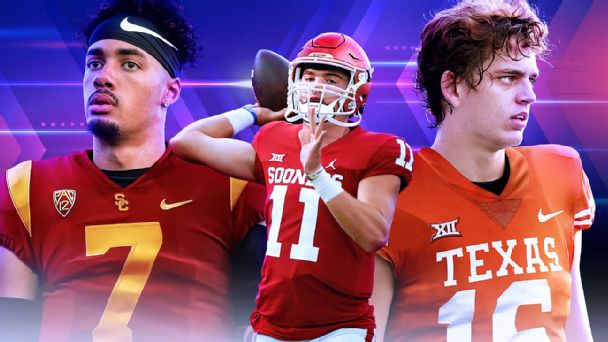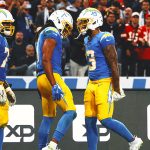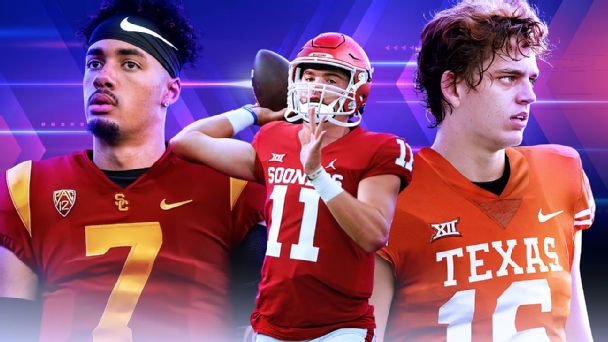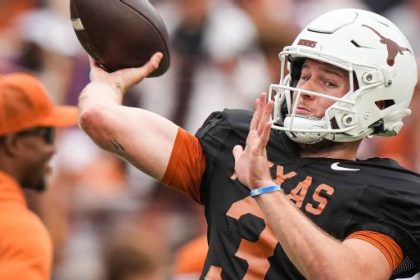
College football‘s 2023 recruiting cycle has all but come to an end after February’s national signing day.
Alabama finished with the No. 1-ranked recruiting class for the eighth time since Nick Saban took over as head coach, and this class could be his biggest yet: five five-star recruits, 13 prospects ranked in the top 50 and 23 ranked in the ESPN 300.
Four quarterbacks are in the top five overall, led by Malachi Nelson, who initially committed to Oklahoma in July 2021 but decommitted and flipped to USC in November 2021, days after Lincoln Riley’s coaching change.
But perhaps no quarterback drew as much attention as Arch Manning, the nephew of Super Bowl champions Peyton and Eli. Manning, who broke his uncles’ Isidore Newman (Louisiana) School records, committed to Texas in June 2022, shortly after the Longhorns spent $280,000 on the recruiting trip when Manning came to visit.
December brought its share of chaos as well. Dante Moore, the No. 2 quarterback in the class, flipped from Oregon to UCLA, while top-10 offensive tackle Kadyn Proctor flipped from Iowa to Alabama. On the first day of the early signing period, five-star safety Peyton Bowen flipped from Notre Dame to Oregon, only to flip his commitment again the following day by signing with Oklahoma.
Top-50 quarterback Jaden Rashada flipped from Miami to Florida and signed with the Gators, but he was released from his national letter of intent less than two weeks ago after his reported $13.5 million name, image and likeness deal fell through. On signing day, he made his destination final, announcing he will join Arizona State.
The cycle is still not technically 100% complete. Duce Robinson, the No. 1 tight end who is ranked No. 40 overall, did not sign a letter of intent on Wednesday. The 6-foot-6, 235-pound Robinson, who is also a coveted baseball prospect, told “College Football Live: Signing Day Special” he plans on playing college football but still needed more time to decide where.
“The plan is fluid,” Robinson said. “I plan on making a decision at some point, hopefully before move-in day … and seeing where the [MLB] draft will take us from there.”
With most of the dust settled, our reporters break down the biggest takeaways from the 2023 recruiting cycle, from how good Alabama’s class will be to the prospects who will impact college football immediately.
Jump to:
Signing day winners | No. 1 class
Arch Manning’s outlook at Texas
Teams hitting needs | Coaching victories
Impact freshmen | Sleepers

Who won the February signing period?
![]()
Tom VanHaaren: Arizona State. Arizona State getting a commitment from quarterback Jaden Rashada was a massive win for Kenny Dillingham and his staff. He’s looking to reshape the roster, and the quarterback position is vital to the team’s turnaround. Dillingham now has Rashada, Notre Dame transfer Drew Pyne and BYU transfer Jacob Conover in the quarterback room. Rashada won’t need to start right away and can get acclimated before he needs to hit the field. Still, he is talented enough to push for early playing time, so it’s a win-win situation for Dillingham.
![]()
Tom Luginbill: South Carolina. Top-40 recruit Nyckoles Harbor was an absolute must-get for the Gamecocks, as all of their scholarship tight ends from the 2022 season moved on, via the transfer portal or graduation. This also sends a message that Shane Beamer and his staff can compete with the blue bloods for some of the nation’s top recruits. With so few prospects left on the board entering Wednesday, beating the likes of Oregon and USC at a needed position speaks volumes. Harbor is raw and needs development, but he may have the most elite blend of size (6-foot-5, 225 pounds), speed (10.28 100-meter) and overall skill in the entire class. If South Carolina didn’t have such a pressing need on offense, he could also have projected as an ideal fit at defensive end.
![]()
Craig Haubert: UCF. Though few ESPN 300 recruits were still available, UCF scored one of the biggest commitments on signing day in four-star LB Andrew Harris. After Harris reopened his recruitment in December, it appeared Maryland was in pursuit, but coach Gus Malzahn was able to bring Harris back into the fold. Surprisingly, his twin brother, Michael Harris, did end up signing with Maryland, but to land one of them (especially the one rated slightly higher) is a key pickup. As the Knights prepare to move to the Big 12, they do so with three ESPN 300 defenders, led by DT John Walker, who is coming off a strong Under Armour All-America performance and could be a plug-and-play addition for them. Adding Harris, who possesses good length, range and room to develop, gives the staff solid building blocks for their shift.
How good is Alabama’s No. 1 class from a historical perspective, and how good can it be?
VanHaaren: Nick Saban got beat by Texas A&M in 2022, but this class he put together was a statement to show everyone he is still on top in recruiting. Alabama’s class has 23 total ESPN 300 commitments with 13 ranked in the top 50 and 19 ranked in the top 150. By comparison, only six teams have more than 13 recruits ranked in the top 300.
Luginbill: I actually believe it’s as good as — if not better than — its 2021 class and Texas A&M’s class from 2022. The reason why it doesn’t receive the same level of notoriety is because everyone has become so conditioned to expect it from Alabama. After all, the Tide have finished atop the class rankings eight times under Saban. If Tennessee, Ohio State or USC had signed this class, we’d be calling it the greatest class ever. We have become spoiled by the Tide’s sustained success.
Haubert: Alabama deflated any intrigue over the No. 1 ranking when it signed four five-star recruits in December. This class reminds me of its 2017 class, the No. 1 class in the ESPN 300 era. That class included two four-star QBs, and while Tua Tagovailoa and Mac Jones leave a high bar to beat, Alabama landed two talented prospects in Eli Holstein and Dylan Lonergan; if one can even closely match the success of those previous two, it will be another huge win.
That 2017 haul also included two ESPN 300 running backs, led by No. 2 RB Najee Harris; this class has the top two RBs in the nation. Both classes have similarly impressive additions in the trenches and the secondary. Their 2023 class does not look to have the same potential at wide receiver that the 2017 class did (Jerry Jeudy and DeVonta Smith). Nevertheless, all the similarities make for great news for an Alabama program looking to return to the top of the college football world.
When will we see Arch Manning take the field, and what can we expect from him?
VanHaaren: It’s not out of the question to think that Manning could come in right away and play for the Longhorns from day one, but a lot depends on his progression once he hits campus. If he can prove to be a more consistent, decisive and accurate quarterback than incumbent starter Quinn Ewers and former four-star Maalik Murphy, then he has a good shot. Despite what critics may say, Manning doesn’t need pressure to go in and start right away, but he has the tools to compete from the jump and is entering a situation in which he’ll at least get a shot to take over.
Haubert: When he committed, I tweeted it would not be surprising if he is able to take the starting job away from Ewers. That task may not be easy, given Ewers is a former five-star himself and showed flashes of that this past season. Why do I think it’s possible we can see Manning this season? He has a nice blend of his talented family’s traits — mobility like his grandfather and father (a former wide receiver) and the arm strength and football instincts of his uncles. Having called two of Manning’s games at Isidore Newman High School, his poised demeanor and toughness in a loss left an impression on me. Holding on to his student ID aside, I do think he could bring a little more attention to detail to the position than his counterparts.
That said, it would be beneficial if Texas can give him some time. Manning is making a sizable jump in competition from one of the smaller classifications in Louisiana to the Big 12 (for now). Meanwhile, Ewers has that Power 5 experience. But whenever Manning does hit the field, I believe he has all the tools to succeed. Sure, he’ll encounter growing pains, but with his physical traits and abilities, he can become the impact player Texas has sought at the position for several years.
Luginbill: Two factors are definitely in play: Ewers’ consistency and the opportunity due to potential injury. Beyond Ewers, Murphy is still in the mix, which means that for Manning to see the field, he would have to be head and shoulders better than every other quarterback on the roster AND college-ready immediately. He’d have to prove to coach Steve Sarkisian he’s the best option and do so without playing in games first. I think it’s best if he redshirts, plays sparingly and becomes the starter as a redshirt freshman — assuming he beats everyone else out.
Which school addressed its biggest needs via recruiting this cycle?
![]()
VanHaaren: Texas. I would go with Notre Dame if we’re including transfers, but strictly on high school recruits, the Longhorns needed a big haul after going 8-5 in 2022. Ewers transferred in from Ohio State and had an up-and-down season, so the staff signed Manning and brought in some competition at the position. The coaches were also able to add some offensive playmakers in receivers Johntay Cook II and DeAndre Moore Jr.
Defense was a priority, as Texas ranked 54th among 131 FBS teams in yards allowed per game and 71st in sacks, and it added the No. 1 inside linebacker in Anthony Hill, the No. 7 corner in Malik Muhammad, the No. 5 safety in Derek Williams, along with six other defensive ESPN 300 recruits. The Longhorns added a few impact prospects who could play in season one and help them compete for a Big 12 championship this year (and eventually an SEC title).
![]()
Haubert: Oklahoma. After looking like a tough miss early on when No. 1 quarterback Malachi Nelson followed Lincoln Riley to USC, Brent Venables and his staff rebounded nicely with fellow five-star Jackson Arnold, who blends excellent arm talent with good mobility. Yes, Dillon Gabriel returns for a fifth year, but Arnold will at least add needed depth to OU’s QB room, if he doesn’t take the job outright.
The defensive-minded Venables finished 99th in points allowed per game in 2022, but addressed that need at all three levels. Peyton Bowen brings elite speed to the secondary. The Sooners also have a pair of ESPN 300 linebackers on board (Samuel Omosigho, Lewis Carter) and had some needed adds to their defensive front, led by five-star Adepoju Adebawore, a lengthy and agile prospect who has a high ceiling for development and can become a fierce edge rusher.
![]()
Luginbill: Alabama. Let’s start with the quarterback. When you lose a generational talent in Bryce Young and sign not one, but two top-10 quarterbacks, obviously you’ve done a terrific job. Simply look at the departures on this roster and how Nick Saban replaced them. Will Anderson Jr. gone. No. 1 OLB Jaquavious Russaw and No. 1 DE Keon Keeley signed. RB Jahmyr Gibbs gone. Nos. 1 and 2 RBs Richard Young and Justice Haynes signed.
Offensive linemen Amari Kight, Javion Cohen and Tommy Brockermeyer enter the portal, No. 2 OT Kadyn Proctor signed. Wide receivers JoJo Earle and Aaron Anderson enter the portal. No. 8 WR Jalen Hale and No. 1 junior college WR Malik Benson signed. Safety Jordan Battle declares for the NFL draft, and Alabama signs the No. 1 safety in the class in Caleb Downs. Bottom line: Alabama signed 17 players who rank in the top 10 of their respective positions in this class, and that doesn’t include two top juco prospects.
Which first-year coach impressed you the most this cycle?
![]()
VanHaaren: Mario Cristobal, Miami. The Hurricanes finished No. 5 in the rankings with 15 ESPN 300 commitments, including two five-star offensive linemen in Francis Mauigoa and Samson Okunlola. In addition to the five total offensive linemen out of high school, the coaches brought in Alabama transfer Javion Cohen and UCF center transfer Matthew Lee, who should be able to help right away and transform that unit. It’s a balanced class from top to bottom that’s bringing in some elite talent to elevate the play at Miami in a hurry.
![]()
Luginbill: Brent Venables, Oklahoma. To say Oklahoma’s defense needed significant improvement would be an understatement, especially after finishing 99th in points allowed per game. Fourteen high school and junior college prospects came on defense, including No. 2 DE Adepoju Adebawore and No. 2 safety Peyton Bowen, both five-stars. The Sooners also did a terrific job, particularly along the defensive front, in the transfer portal with the additions of edge player Dasan McCullough coming in from Indiana and DE Trace Ford arriving from in-state rival Oklahoma State. This is a really good foundation for Venables’ first full cycle.
![]()
Haubert: Dan Lanning, Oregon. Multiple classes within the top 10 were led by head coaches who wrapped up their first full recruiting cycle, making this a tough question. Lanning took over a program with a lot of resources and that had been recruiting at a high level, and he also came in hot having led Georgia’s stifling championship defense in 2021. Having spent the better part of the last decade in the Southeast and this being his first head coaching job, there were no guarantees.
Even after losing five-star QB Dante Moore before the early signing period, Lanning did an excellent job. The Ducks snagged ESPN 300 QB Austin Novosad, landed ESPN 300 defender Matayo Uiagalelei from California (a key recruiting footprint) and kept active nationally with signings out of Florida, D.C. and Mississippi. On signing day, Lanning brought in top-100 cornerback Rodrick Pleasant, whose blazing 10.14 100-meter speed will help in the secondary and possibly the return game. After a three-year run of signing the Pac-12’s top class, the Ducks fell to fourth in the 2022 cycle, but with a full year on the trail, Lanning returned Oregon to the top of the conference’s recruiting rankings.
Which recruit will have the best freshman season?
![]()
VanHaaren: Peter Woods, Clemson (DT, No. 5). Woods could make a lot of noise at Clemson along the defensive line. He is a five-star defensive tackle at 6-3, 275 pounds and is exactly what Clemson looks for up front. He’s big, strong, fast and should contribute early in some way, especially with some of the departures up front for the Tigers (Bryan Bresee, Myles Murphy). Woods was highly sought-after and eventually could be a versatile lineman who can play in any defense.
![]()
Luginbill: Zachariah Branch, USC (WR, No. 7). Whether he becomes a consistent factor in the passing game or an impact player as a return man, it’s going to be hard to keep Branch off the field. With the loss of Jordan Addison to the NFL draft, Branch is arriving at the perfect time and will have reigning Heisman Trophy winner Caleb Williams throwing him passes. Branch can play everywhere and is a faster version of Mario Williams.
![]()
Haubert: Suntarine Perkins, Ole Miss (OLB, No. 18). This past season, five-star LB Harold Perkins Jr. was a breakout freshman player for LSU, so it makes sense to me to go with a player who reminds me of him here. The fact that they share the same last name is just a happy coincidence; their similarities come from them both being lengthy, versatile players who each excelled on both sides of the ball in high school. Much like the Tigers standout, Suntarine is a fluid player with excellent range who also possesses an aggressive style. He was a huge in-state get for the Rebels, and opportunity will be there to play right away, with the tools to produce similar results to the other Perkins in Baton Rouge.
Who is your favorite sleeper recruit of the cycle?
![]()
VanHaaren: Tyriq Blanding, Penn State (DT, three stars). Penn State coach James Franklin made it a point to single out Blanding at his December press conference, asking why more people weren’t talking about Blanding, who has played linebacker, defensive end and defensive tackle in high school. He’s a bit undersized (6-2, 280), but Penn State has developed dynamic defensive players really well in the past, namely with Micah Parsons, who played running back, linebacker and defensive line. Blanding is a three-star prospect from New York who chose the Nittany Lions over schools such as Oregon and Michigan.
![]()
Luginbill: Mikey Matthews, Utah (WR, No. 291). Matthews worked himself into the final edition of the 2023 ESPN 300 with a terrific week at the Under Armour All-America game. He’s a great example of how far Utah has come as a program and the caliber of player the Utes have access to and are capable of signing. He still flew under the radar on a national scope, but we’d anticipate him playing a lot of football early on for the two-time defending Pac-12 champions.
![]()
Haubert: Keldric Luster, SMU (QB, three stars). I am swinging for a player who could be the ultimate sleeper. Built like a running back (5-10, 230) without looking the part, Luster simply gets the job done. As a sophomore, he was his district’s newcomer of the year, and as a junior he was named overall MVP after accounting for 5,000 yards of total offense and 54 TDs at Frisco Liberty (Texas). This past season at McKinney High School, he threw for more than 2,000 yards and rushed for over 700 yards. It is tempting to project him at running back, but I commend SMU for seeing past his measurables. He can sling it with good arm strength and a compact release, touts impressive playmaking skills and, with time in Rhett Lashlee’s offense, should thrive.












